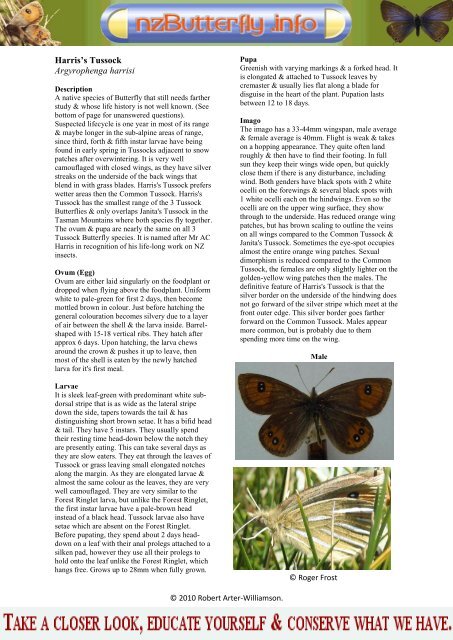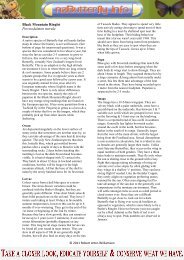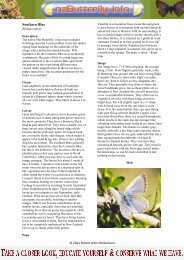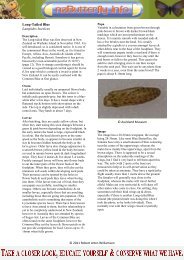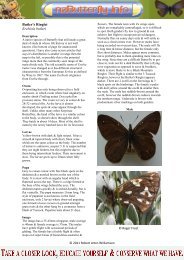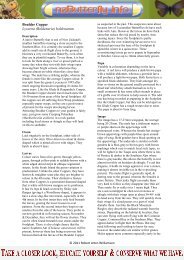Harris's Tussock Argyrophenga harrisi - NZ Butterfly Info
Harris's Tussock Argyrophenga harrisi - NZ Butterfly Info
Harris's Tussock Argyrophenga harrisi - NZ Butterfly Info
You also want an ePaper? Increase the reach of your titles
YUMPU automatically turns print PDFs into web optimized ePapers that Google loves.
Harris’s <strong>Tussock</strong><br />
<strong>Argyrophenga</strong> <strong>harrisi</strong><br />
Description<br />
A native species of <strong>Butterfly</strong> that still needs farther<br />
study & whose life history is not well known. (See<br />
bottom of page for unanswered questions).<br />
Suspected lifecycle is one year in most of its range<br />
& maybe longer in the sub-alpine areas of range,<br />
since third, forth & fifth instar larvae have being<br />
found in early spring in <strong>Tussock</strong>s adjacent to snow<br />
patches after overwintering. It is very well<br />
camouflaged with closed wings, as they have silver<br />
streaks on the underside of the back wings that<br />
blend in with grass blades. <strong>Harris's</strong> <strong>Tussock</strong> prefers<br />
wetter areas then the Common <strong>Tussock</strong>. <strong>Harris's</strong><br />
<strong>Tussock</strong> has the smallest range of the 3 <strong>Tussock</strong><br />
Butterflies & only overlaps Janita's <strong>Tussock</strong> in the<br />
Tasman Mountains where both species fly together.<br />
The ovum & pupa are nearly the same on all 3<br />
<strong>Tussock</strong> <strong>Butterfly</strong> species. It is named after Mr AC<br />
Harris in recognition of his life-long work on <strong>NZ</strong><br />
insects.<br />
Ovum (Egg)<br />
Ovum are either laid singularly on the foodplant or<br />
dropped when flying above the foodplant. Uniform<br />
white to pale-green for first 2 days, then become<br />
mottled brown in colour. Just before hatching the<br />
general colouration becomes silvery due to a layer<br />
of air between the shell & the larva inside. Barrelshaped<br />
with 15-18 vertical ribs. They hatch after<br />
approx 6 days. Upon hatching, the larva chews<br />
around the crown & pushes it up to leave, then<br />
most of the shell is eaten by the newly hatched<br />
larva for it's first meal.<br />
Larvae<br />
It is sleek leaf-green with predominant white subdorsal<br />
stripe that is as wide as the lateral stripe<br />
down the side, tapers towards the tail & has<br />
distinguishing short brown setae. It has a bifid head<br />
& tail. They have 5 instars. They usually spend<br />
their resting time head-down below the notch they<br />
are presently eating. This can take several days as<br />
they are slow eaters. They eat through the leaves of<br />
<strong>Tussock</strong> or grass leaving small elongated notches<br />
along the margin. As they are elongated larvae &<br />
almost the same colour as the leaves, they are very<br />
well camouflaged. They are very similar to the<br />
Forest Ringlet larva, but unlike the Forest Ringlet,<br />
the first instar larvae have a pale-brown head<br />
instead of a black head. <strong>Tussock</strong> larvae also have<br />
setae which are absent on the Forest Ringlet.<br />
Before pupating, they spend about 2 days headdown<br />
on a leaf with their anal prolegs attached to a<br />
silken pad, however they use all their prolegs to<br />
hold onto the leaf unlike the Forest Ringlet, which<br />
hangs free. Grows up to 28mm when fully grown.<br />
Pupa<br />
Greenish with varying markings & a forked head. It<br />
is elongated & attached to <strong>Tussock</strong> leaves by<br />
cremaster & usually lies flat along a blade for<br />
disguise in the heart of the plant. Pupation lasts<br />
between 12 to 18 days.<br />
Imago<br />
The imago has a 33-44mm wingspan, male average<br />
& female average is 40mm. Flight is weak & takes<br />
on a hopping appearance. They quite often land<br />
roughly & then have to find their footing. In full<br />
sun they keep their wings wide open, but quickly<br />
close them if there is any disturbance, including<br />
wind. Both genders have black spots with 2 white<br />
ocelli on the forewings & several black spots with<br />
1 white ocelli each on the hindwings. Even so the<br />
ocelli are on the upper wing surface, they show<br />
through to the underside. Has reduced orange wing<br />
patches, but has brown scaling to outline the veins<br />
on all wings compared to the Common <strong>Tussock</strong> &<br />
Janita's <strong>Tussock</strong>. Sometimes the eye-spot occupies<br />
almost the entire orange wing patches. Sexual<br />
dimorphism is reduced compared to the Common<br />
<strong>Tussock</strong>, the females are only slightly lighter on the<br />
golden-yellow wing patches then the males. The<br />
definitive feature of <strong>Harris's</strong> <strong>Tussock</strong> is that the<br />
silver border on the underside of the hindwing does<br />
not go forward of the silver stripe which meet at the<br />
front outer edge. This silver border goes farther<br />
forward on the Common <strong>Tussock</strong>. Males appear<br />
more common, but is probably due to them<br />
spending more time on the wing.<br />
Male<br />
© Roger Frost<br />
© 2010 Robert Arter-Williamson.
Female<br />
Distribution<br />
Habitat<br />
Montane to subalpine tussock, between altitudes of<br />
800-2000m.<br />
Phenology<br />
Food Plants<br />
Broad-leaved Snow <strong>Tussock</strong> (Chionochloa<br />
flavescens) in the sub-alpine zone, Snow <strong>Tussock</strong><br />
(Chionochloa spp) & Other <strong>Tussock</strong>'s (Poa spp).<br />
Status<br />
Rare Found in North West Nelson, Mt Owen &<br />
Lewis Pass. It has declined due to improved<br />
pastures for farm animals & burning of <strong>Tussock</strong><br />
areas to improve the palatability of <strong>Tussock</strong>s for<br />
Sheep.<br />
Copyright<br />
All content belongs to Robert Arter-Williamson<br />
and www.nzbutterfly.info.<br />
Factsheet Design lay out by Stuart Desjardins.<br />
© 2010 Robert Arter-Williamson.


